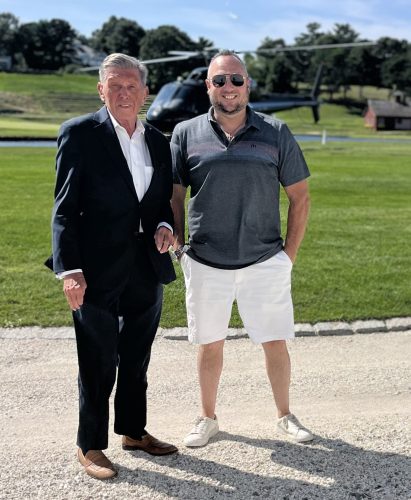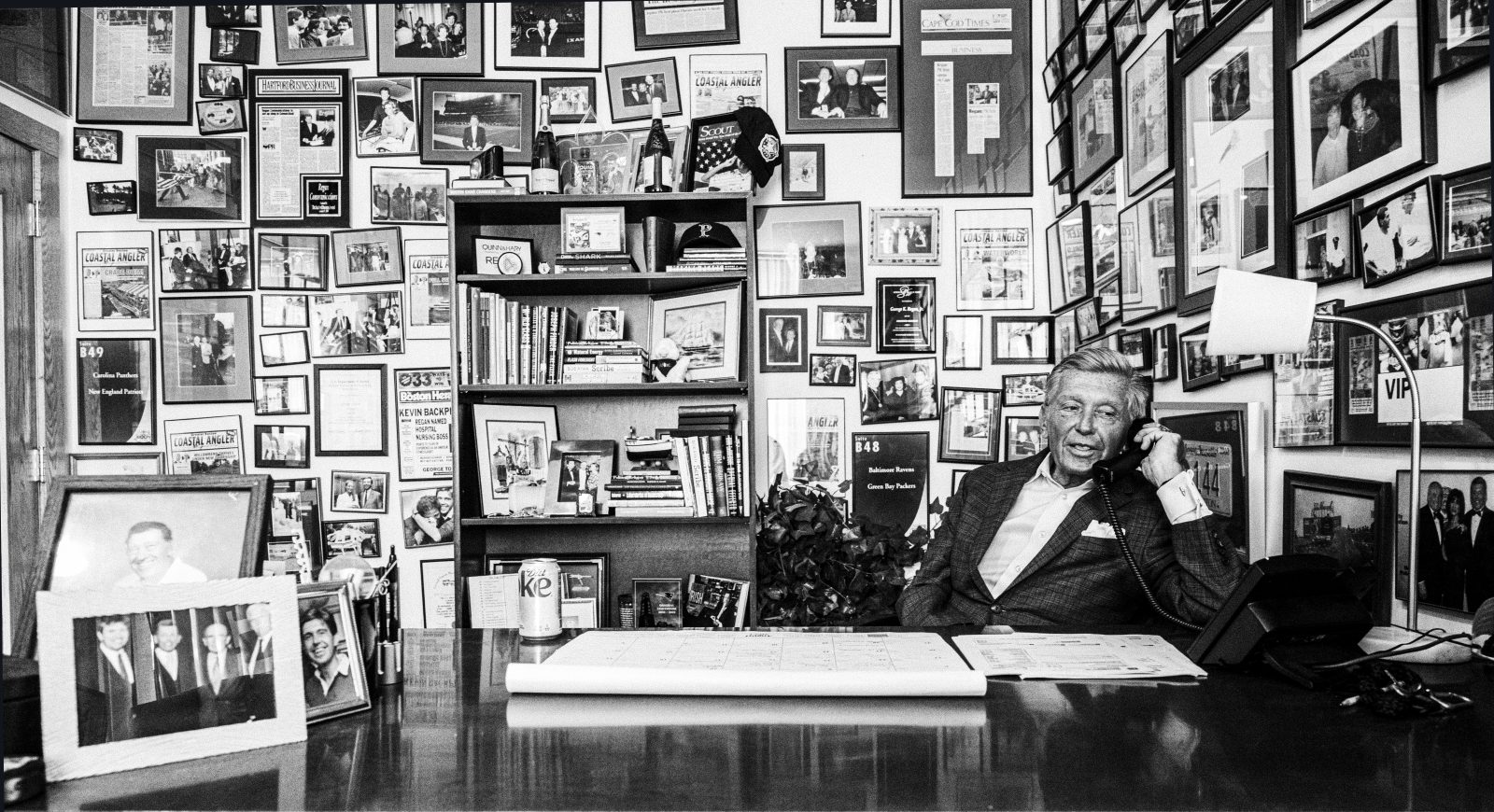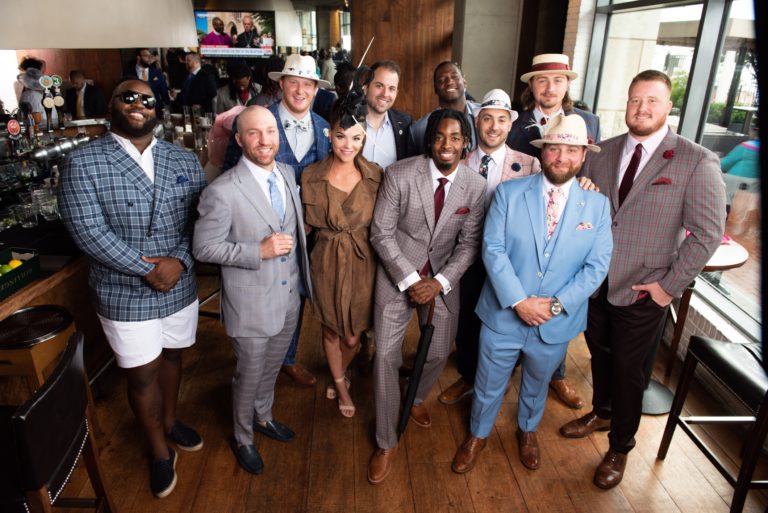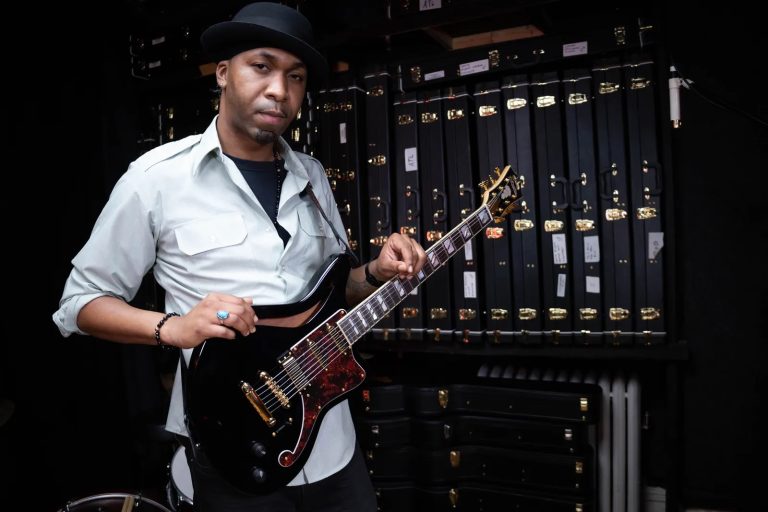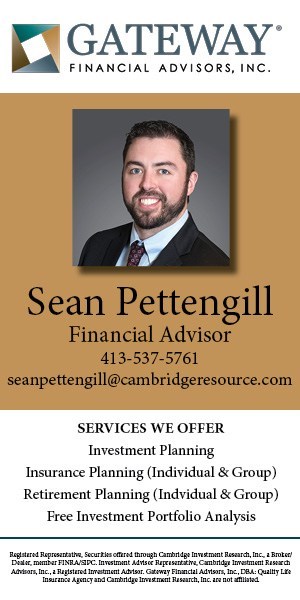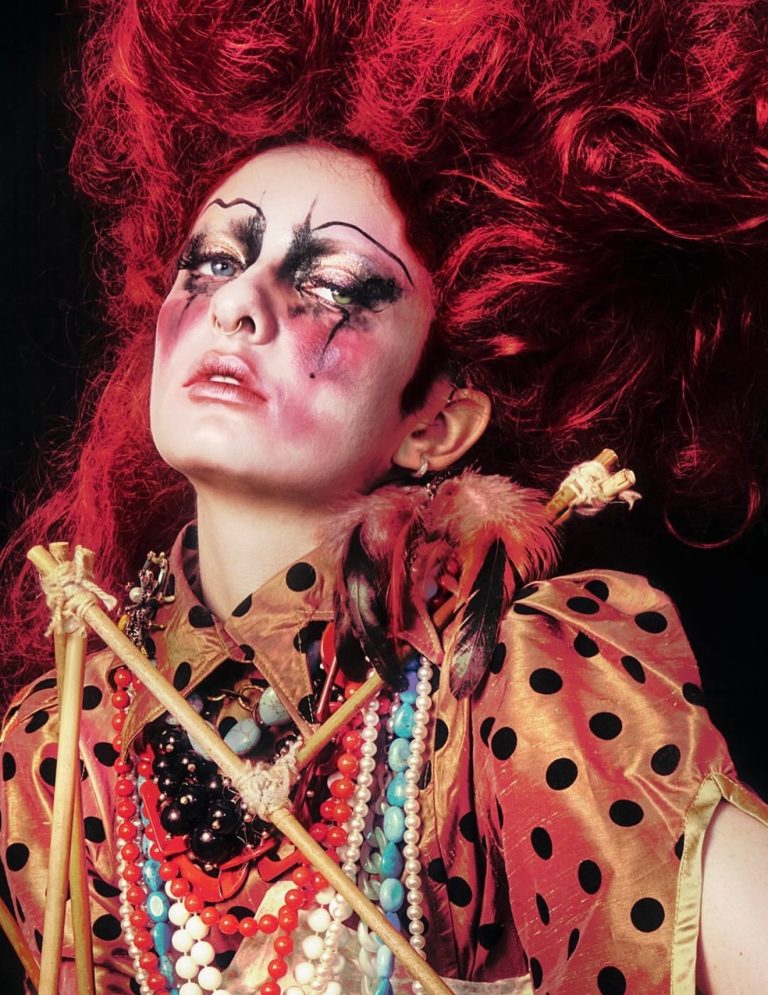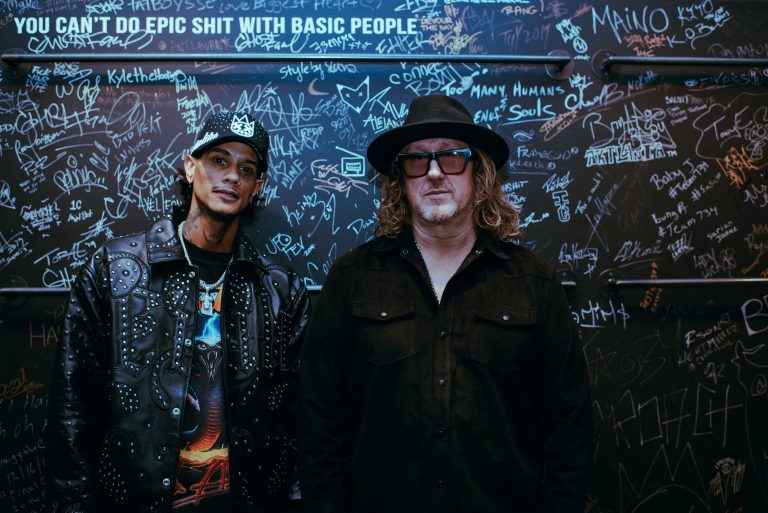Forty years is a long time. A lifetime is even longer. As George K. Regan Jr. prepares to celebrate a milestone anniversary since the opening of his juggernaut public relations firm in 1984, he spent some time with BostonMan Magazine to reflect on his agency and a lifetime dedication & love for the city of Boston.
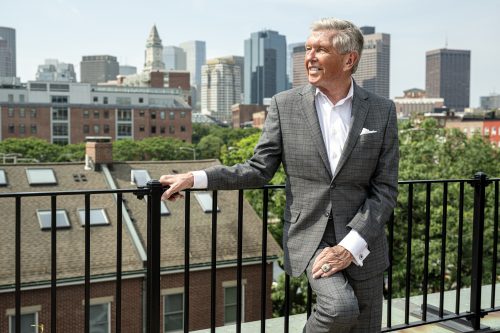
IT’s an early morning in late August. The type of morning that could be the archetype for the proverbial “lazy days of summer” in New England. The temperature and humidity, not yet hitting the uncomfortable highs they will later in the day, a lot of Bostonians choose mornings like this to put the ‘OOO’ reply on their emails and spend the day laying in grass or sand, walking through waves, reading a light book, and lounging poolside while spending time with family and friends.
Inside the offices of Regan Communications headquarters at 106 Union Wharf on the waterfront, however, this morning is anything but lazy.
“If God gave you the gift of good, healthy lungs you have a voice, don’t be afraid to use it,” Regan Communications patriarch George K. Regan, Jr tells me in his office, as celebrated photo-journalist Eric Snyder snaps the images for this cover story you now hold in your hands.
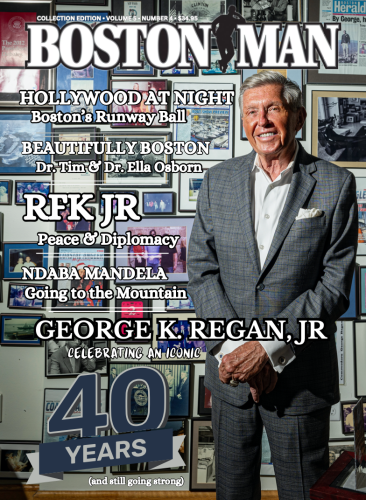
The quote -and lesson- originally given to George from his mentor and friend, Kevin White, 50th mayor of Boston- (who George stood side-by-side with for the majority of his four consecutive terms) is one of many he has absorbed throughout the course of a lifetime serving first the city of Boston, and later his nationwide client base.
Everywhere you look around Boston, you see footprints of George’s dedication to the city. He is among Boston’s most influential power brokers and philanthropists. His firm, celebrating its 40th anniversary in 2024, is the largest privately owned public relations agency in New England, and sixth largest in the country.
He is an avid supporter of numberless charitable organizations including: Friends of the Boston Police, The American Liver Foundation & The Anti-defamation League (both where he was recognized as Man of the Year,) Carroll Center for the Blind, Boys & Girls Club of Cape Cod, Urban College of Boston, Boy Scouts of America (where he was an Eagle Scout,) The Angell Memorial Fund, the Commonwealth Zoological Corporation, and The Children’s Trust, the last two of which he was appointed to by Governor Charlie Baker.
And just last year he married “the love of my life and better half” Elizabeth, in a ceremony that grabbed headlines in The New York Times.
Having just celebrated his 73rd birthday, George is showing no signs of slowing down. He still makes the 90-minute drive from his Cape Cod home to his North End waterfront office every morning; and still defends and promotes the city of Boston with the same valor and vigor he did in the 1970’s with Mayor White, some of which comes with pushback from adversaries, just as it did fifty years ago.
As President Theodore Roosevelt, a Harvard graduate and one-time Bostonian himself, so accurately pointed out years ago: It is not the critic that counts, however. It is the man in the arena that matters. The doer of deeds, who knows great enthusiasms, great devotions, and spends himself in a worthy cause.
George K. Regan Jr has spent his lifetime in that arena. This is his story.
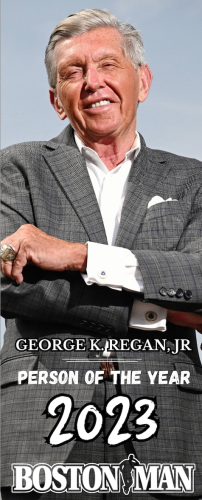
PART I – Birth of a Titan
GEORGE K. REGAN, JR was born on August 25th 1950 in Quincy, Massachusetts to first generation American parents Ann Theresa Kowalski (Regan) and George K. Regan, Sr.
His father’s family settled in South Boston from County Cork, Ireland in the early 20th century and his mother’s family moved to Boston’s South End from Poland around the same time.
The elder George and Ms. Kowalski met on a brisk and sunny morning in the autumn of 1948 while both were taking a bus. George was en route to a minor league baseball game, and Ann, on her way downtown to work.
George attempted to charm Ann that morning with stories from his barnstorming baseball days, which led to tryouts with Major League Baseball’s Boston Braves, who from 1871 to 1952 called ‘Braves Field’ on Commonwealth Ave -the current site of Boston University’s ‘Nickerson Field’- home.
The Braves, in fact, were just as much the talk of the baseball town as Boston’s beloved Red Sox then. Led by the great Warren Spahn on the mound -who would go on to lead the National League in victories eight times while amassing 363 total wins over the course of his Hall of Fame career- the Braves won the National League pennant in 1948, priming the city for an ‘all Boston’ World Series.
It wasn’t meant to be though. On the final day of the regular season Ted Williams and the Red Sox bowed out to the Cleveland Indians in a one-game playoff for the American League pennant, 8-3, before the Braves too would stumble in six games to the Indians in the World Series.
“I didn’t know how much of what he was telling me was totally true,” Ann chuckled remembering that morning years later. “But there was something so innocent and delightful about the way we spoke to each other.”
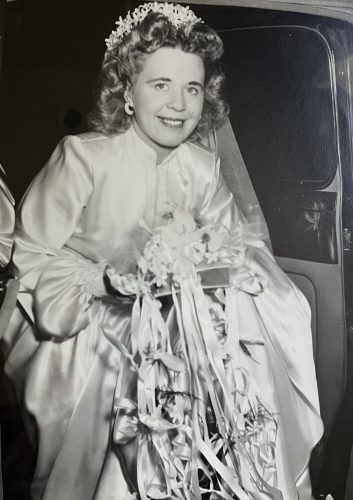
Smitten following their initial bus ride, Ann and George Sr rarely left each other’s side. In the first year of peace following World War II, two million new couples were married, among them, George K. Regan Sr and Ann Theresa Kowalski. By 1952, there were twenty-five million new births in a seemingly endless baby boom.
1950’s America for the Regans was emblematic of middle-class families around Boston at that time. Our G.I.s had returned home, bringing with them visions of a new ‘American Dream.’ Pride in country and community was at an all-time high and families were settling into safe neighborhoods with yards, white picket fences and dogs. At every home flew an American flag. It was Pax Americana.
William Levitt, utilizing development advancements he absorbed in the Navy during WWII, became the ‘Father of Modern Suburbia,’ refining assembly line construction to produce mass affordable housing in short time for the influx of newlyweds and young families that came with post-war prosperity. A family could now own a home for a fraction of the cost it would have been pre-war.
Around this time, the Regans became first time homeowners as well, purchasing a small house in Wollaston where they would begin to build their own family: George Jr, and his two sisters Marianne and Patricia Ann.
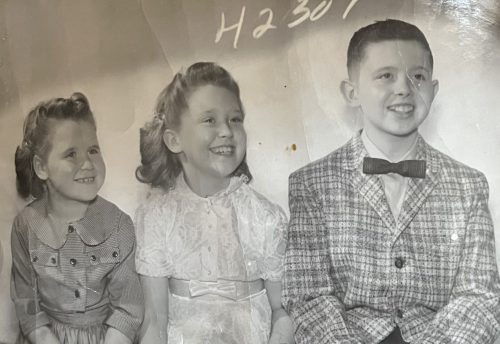
Ann’s older sister Mary soon moved in from the South End, helping to raise the burgeoning family, just as she had done years earlier with her orphaned younger sister.
“My Aunt Mary was like a second mother to me,” George Jr fondly recalls. “I never got to meet my grandparents on either my maternal or paternal side. It was a different time, they all died young. My mother’s parents passed away during the Great Depression, and it was my Aunt Mary who nourished and cared for (my mother) taking on the responsibilities of a parent.”
George Jr’s youth was tantamount with others his age in his Wollaston neighborhood. He thrived in his academics, participated in sports, attended Catholic church on Sundays with his family, loved dogs and animals, and played with his friends whenever he could.
With the proximity of their Wollaston home to the ocean, the Regans spent many summers days fishing. One particular newsworthy catch by Ann was entered into a local Sears, Roebuck store’s annual fishing competition for which she ultimately won an award. Embarrassed by the attention the catch was generating from local media, she deferred the winning feat to her son.
Later, during the awards ceremony a reporter asked young George his thoughts on reeling in such a magnificent fish. He shook his head and confessed.
“I didn’t catch it,” he said. “My mother did.”
With cameras and reporters everywhere, George points to this as one of his first impressions with media.
“My mother was not proud of the way I handled the situation and I think that is one of the major reasons why I got into public relations.”
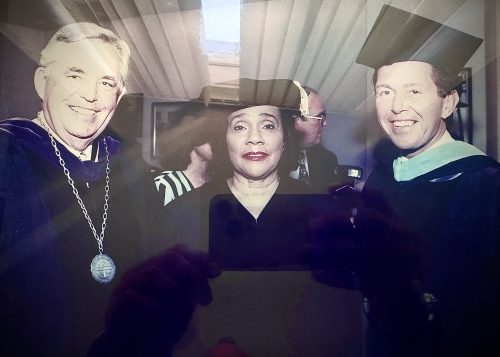
AFTER graduating from North Quincy HS in 1968, George enrolled at nearby Suffolk University.
“I originally wanted to go to school to be a veterinarian,” George reveals. “But God had a different plan for me.”
Truth be told, George simply wasn’t about to wander too far from the nest.
“He was too much of a ‘mama’s boy,’” his wife Elizabeth says with a smile.
“It’s true,” George confirms laughing. “Every big moment in my life, my mother was there to send me off, wishing me well. She had a superstition that if she dressed me in a brand-new set of ‘good luck’ underwear I would succeed at whatever it is I was set out to do that day.”
A lot was going on in 1968. Astronauts went towards the moon. The country was divided on Vietnam. We lost MLK and RFK within two months of each other. Muhammad Ali posed for Esquire Magazine with arrows through his body. Richard Nixon took over the White House. And Bill Russell’s Boston Celtics defeated Jerry West’s Los Angeles Lakers to capture their record tenth NBA Championship.
It was also in the autumn of ’68 that a young George Regan embarked onto his first job in media, reporting for duty to the Boston Globe.
Initially hired as a messenger in the advertising department, George’s assignment was to gather final ad copy from various advertisers along a designated route. This was well before the time of digital delivery so each afternoon ‘ad messengers’ would round up all of the ads to be published in the next day’s newspapers.
“So I went about my business, collected my ads. I had a good route with Macy’s and some other decent sized advertisers on it,” George explains. “I was feeling pretty good about my first day.”
There was only one problem.
“My mother only gave me $3, it was a hot July day, and I ran out of money resulting in me having to walk back to the Globe and when I got there, everyone was furious with me. Apparently, I was supposed to call the office for a ride back instead of walking. I was hours late, and we ended up missing our print deadline that evening.”
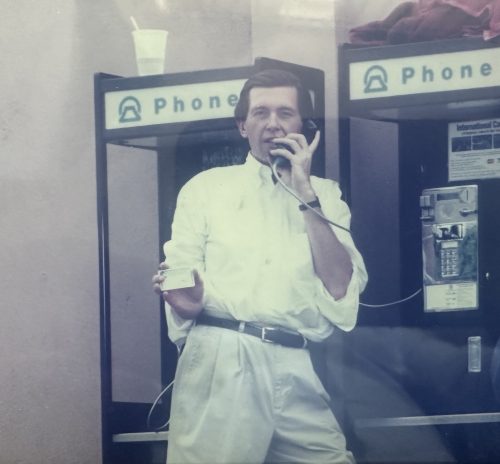
The next day George would be reassigned to the copy room, which he admits “was probably a better fit for me.”
There, at seventeen years old, he would become the youngest Boston Globe writer to ever have a by-line.
“I basically did whatever they needed me to do,” George says.
Which included the occasional undercover assignment.
In the late 60’s, the Globe received a tip about an on-going narcotics investigation along Quincy Shore Drive and Wollaston Beach that authorities were being extremely tight lipped about. Anyone or anything that that was believed to be even remotely close to media related was quickly removed from the area.
But still a teenager -with a baby face to boot- and an intimate knowledge of the Quincy shore line, the Globe reasoned that George could blend in and perhaps get the scoop on the scope of whatever the investigation and scandal was about.
“So they basically assigned me to go down there and just hang out and observe for a month, see what I could find out,” George discloses. “I was paid to be a spy.”
For the next few weeks George chatted up and listened to the locals at Squantum and Wollaston Yacht Clubs, The Clam Box, Tony’s Clam Shop, Wollaston Beach Playground, and other local spots. He took note of who or what seemed out of place; anything he deemed suspicious and out of the norm. Each evening he went back to the Globe and reported his findings.
“When we finally broke the story (other media outlets) were like ‘How did you get that information? Who is your source?’ Nobody knew it was just me snooping,” George says grinning.
FOLLOWING his graduation from Suffolk, George went on to Boston University School of Communications where he received his masters degree in writing on a full scholarship.
Young, ambitious, and with multiple degrees in hand, George was ready for a new adventure. That’s when he received a call from a colleague, he had become friendly with over at the Boston Herald. He informed George that he had just wrapped up a temporary position with Mayor Kevin White’s office and that Mayor White’s team was looking for some fresh energy to fill some open spots on his press team.
“That caught my attention,” George says. “So I went into City Hall the next day and applied.”
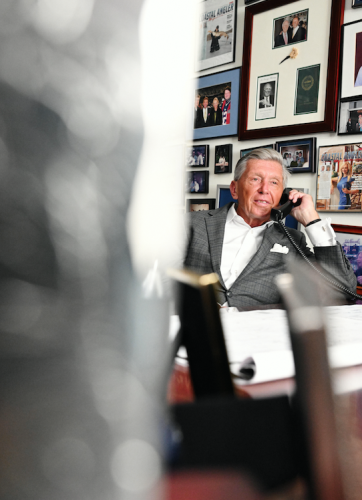
PART II – Running the City
GEORGE REGAN sat in the mayor’s office at 1 City Hall Square in Boston, brand new set of underwear from Ann in tow. Behind the majestic desk in front of him -sizing him up- was Kevin White, Boston’s mayor since 1968, and before that the Secretary of the Commonwealth.
If ever there was a man bred to be a leader in Boston, it was White. Born in the Jamaica Plain neighborhood of the city on September 25th, 1929, White was the son of Joseph C. White, a former state legislator and Boston City Council president. His wife, Kathryn, was the daughter of William J. Galvin, another Boston City Council president.
On April 5th, 1968 -one day after the tragic assassination of Martin Luther King Jr- Mayor White stood on stage with James Brown at the Boston Garden to appeal to the audience, and an entire grieving city, to remember and maintain King’s peaceful vision in mourning. While almost every major city across the US experienced civil disturbances in the immediate aftermath of King’s death, Boston -in no small part to Brown and White’s messaging that evening- remained relatively disturbance free.
Recently re-elected for his second of what would be four consecutive terms as Boston’s mayor, George was hoping to make enough of an impression on Mayor White to be able to join his office in some capacity.
“The interview barely lasted five minutes,” George states. “He didn’t think I was ready and wanted a national candidate.”
The next week, an administrator from White’s office called George confirming what he had suspected the mayor’s thoughts were, but the call also came with a unique caveat.
“They needed the help. They told me they wanted to hire me and basically hide me from Mayor White until I had proven my worth,” George explains. “I agreed to the terms on the spot.”
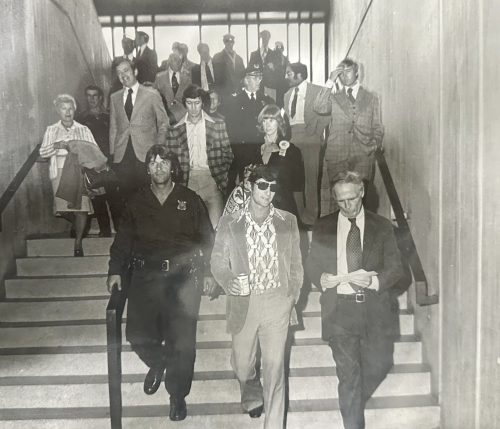
The early 1970’s was a turbulent and transcendent time period in Boston’s history. With that came the fortuity for George and anyone else working for Mayor White to make a lasting impact on the future of the city.
So George buckled down and got to work on whatever the mayor’s office need be addressed.
“There was so much to do. The opportunity to carve your own lane and make positive contributions in the city were there for us daily under Mayor White,” George reflects.
In addition to the chief executive duties for the city of Boston, White was co-chair of the Democratic Election Committee with then Georgia governor Jimmy Carter.
The year was 1973, and the Republican party was in turmoil. Daniel Ellsberg (living in Cambridge) had released the Pentagon Papers exposing the government’s secret war in Vietnam. Vice President Spiro Agnew had just been forced to resign by the Justice Department on allegations he had accepted a $10,000 bribe while in the oval office. And months later President Nixon, too, would resign amid the Watergate scandal.
Gerald Ford was being unfairly cast in the media -at the hand of his portrayal by Chevy Chase on Saturday Night Live– as a clumsy idiot due to his tendencies to trip and slightly stumble over things while on camera.
If ever there was a time for the Democratic party to reclaim the White House, it was going to be the election of 1976.
And both Kevin White and Jimmy Carter knew it.
“I was assigned to travel and set up all of the media interviews for Mayor White from coast to coast to see if the reporters had the appetite for a big city mayor running for President,” George says. “I would arrive to a city two or three days ahead of Mayor White and his entourage and essentially set up whatever our campaign was going to be in that city.”
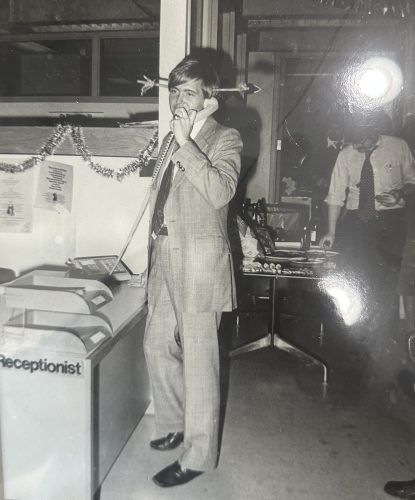
On what such stop, George had helped assemble a blood drive in Detroit at which Mayor White publicly donated his own blood to support local hospitals in need; aired on WXYZ’s morning show with a live interview while giving the blood.
By the mayor’s own estimate, the drive was “a bloody success” and he wished to personally thank the member of his staff who had organized the effort. When directed to one of the automobiles in his caravan for which said staff member was aboard, White chose to ride in that vehicle rather than his own back to the hotel. As he opened the door, he took a seat right next to the event organizer.
“What the hell are you doing here?” Mayor White exasperated upon seeing George. A smile quickly broadened across the mayor’s face though. “Welcome to the team kid, you did an incredible job with this first exploratory presidential trip.”
“The thing is,” George acknowledges all of these years later. “Mayor White was absolutely correct in his reasoning for not wanting to initially hire me. I was too young, too immature, and too inexperienced. I am grateful the people around him created the opportunity for me to gain some experience in other facilities, which allowed me to continue to develop and prove myself.”
From that moment, George became a trusted confidant, colleague, and one of two top advisors (along with Micho Spring) to the mayor.
He would quickly ascend to becoming press secretary for the mayor, and the two would develop a fast friendship that would last a lifetime. Mayor White would become George’s mentor, and George was someone the mayor said:
“I knew I could trust to get things done for me, for the city, and for the country.”
He would also refer to George as his “third son.”
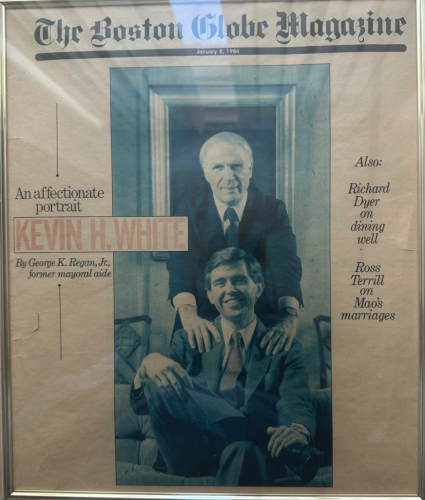
Mayor White and George kept a torrid schedule that would dizzy most. They continued to canvas the country together (along with Ira Jackson, White’s other top aide who went on the run the Kennedy School of Politics,) making inroads to ensure a democrat -be it White, Carter, (Massachusetts senator) Ted Kennedy, (California governor) Jerry Brown, (Arizona representative) Morris Udall, or (Washington senator) Henry Jackson- would be seated in the oval office at the conclusion of the next election.
“We were very well received everywhere we went,” George remembers. “Kevin, Ira, and myself were be-bopping back and forth from Boston to whichever city was next on our campaign schedule. Carter was relatively unknown on the national stage at the time and the more we campaigned the more it was looking like Kevin could emerge as the democratic candidate.”
Back home in Boston, however, the city was in desperate need of the mayor’s full-time attention, and leadership.
“It was a difficult time in the city,” George explains. “Kevin essentially needed to end his own Presidential hopes, to put the greater needs of Boston first.”
ON June 21st, 1974, US District Court Judge W. Arthur Garrity Jr ruled that the Boston School Committee had “systematically disadvantaged black school children” in the public school system. The only remedy, the judge concluded, was to begin busing students between predominantly white and predominantly black neighborhoods to desegregate the city’s public high schools.
The school in the neighborhood with the largest African-American population was Roxbury High School. The school in the neighborhood with the largest white population was South Boston High School. It was decided that these two schools would switch a significant portion of their student bodies.
This order was to take place at the beginning of the school year on September 12th, 1974. Students, parents -and Mayor White and top staffers, including George- had less than ninety days from the date of the ruling to prepare.
Tensions and anxieties were reaching a boiling point in the city, and this time period is marred by several incidents where racism reared its ugly head.
“I wish I knew a way to have taught Garrity, or convinced him to be more generous; softer in his implementation of that order,” White would say years later.
Never totally comfortable with busing, White and George, at the time and in reflecting on its aftermath, called busing “too severe.”
Mayor White made it their number one priority to protect ALL school children from any type of violence, and utilized federal and state assistance wherever they could in doing so.
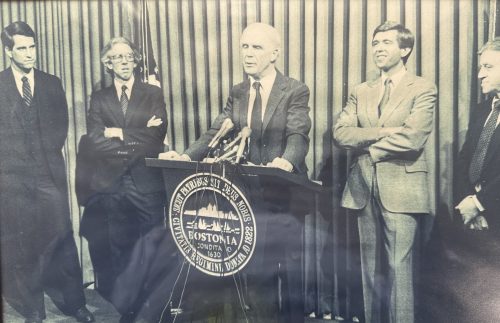
White and George narrowly escaped with a tumultuous re-election bid in 1975, the third of four consecutive terms in the mayor’s tenure.
During the period of crisis, George helped Mayor White organize a 30,000 strong march to protest all forms of racial violence, in Boston and throughout America.
“We were doing everything we could to keep the city safe and move it forward at the same time,” George says.
Part of moving the city forward was the planning of the Bicentennial Celebration, dubbed “Boston 200” which ran from April 18th 1975 through December 1976.
Mayor White and George helped orchestrate a Boston Pops spectacular on the Esplanade that drew over 400,000 people, marked by the Guinness Book of World Records at the time as the largest crowd ever assembled for a classical music concert.
Then, a week later, they welcomed Queen Elizabeth and Prince Phillip to Boston, denoting the first visit of a reigning British monarch to Massachusetts.
“We were given very specific instructions from the US State Department not to touch the Queen under any circumstance,” George explains of the conditions that came with hosting her majesty. “But once she was off of the royal yacht and greeted us, it wasn’t five minutes before the mayor and her had their arms around each other like two old friends.”
George smiles at the memory, “That was Kevin for you.”
Part of the festivities that George had helped arrange for Queen Elizabeth was a private luncheon with 192 incredible VIPs from across the country in Mayor White’s City Hall office.
For weeks, George and the team meticulously reworked the mayor’s office, spending thousands of dollars on the makeover, which included stunning state-of-the-art floor to ceiling windows.
“We had round up the most expensive wines from all of the finest restaurants throughout the city in preparation for the luncheon,” George says.
But once seated, the Queen pulled her new pal Mayor White in with a special request.
“Would you be able to find me a gin and tonic anywhere?”
Upon hearing this, Prince Phillip motioned for the mayor to lean in towards him as well.
“All I want is a cold beer.”
So George, as he always does, sprang into action. It was a Sunday, so all of the liquor stores were closed (in 1976 package stores closed on Sunday.) He swiftly explained to the police motorcycle blockade in front of city plaza what the dilemma was and within minutes uniformed officers were bringing serving trays of the requested spirits from Faneuil Hall restaurants into the luncheon!
“Everyone was able to enjoy their beverage of choice,” George grins.
Royal crisis averted.
MEANWHILE on the national scene, Carter after jumping out to an initial lead in the primaries with White withdrawn from the ballots, was careening in the polls.
In May (1976) he got crushed by Brown in Maryland and barely edged out Uddall in Michigan. The Carter campaign was reeling, and they were in search of a fresh injection to rejuvenate it.
As co-chair of the Democratic Election Committee with White, Jimmy Carter’s press secretary, Jody Powel, had seen firsthand the precision and skill George was exhibiting in his diligent planning of White’s media strategies. It was the missing piece he felt he needed to propel him to the presidency.
“I was offered a competitive position on the campaign, which would give me direct say in a lot of the planning,” George explains.
There was only one challenge.
“Kevin was going to have to sign-off on a leave of absence in order for me to fulfill my commitment to Carter.”
Unbeknownst to many -even to this day- despite the capacity they worked together in the democratic election committee, Kevin White and Jimmy Carter were not the best of friends.
Quite frankly, “they hated each other,” George reveals.
So when George approached Mayor White about the sign-off to join the Carter campaign, he was met with an icy glare.
“Is this something you really want to do?” White asked George.
“Yes, I do,” George told his mentor.
“Well then, good luck and god speed.”
With that, George hit the ground running, helping Carter to beat out his rivals and officially secure the democrat nomination for President at NYC’s Madison Square Garden.
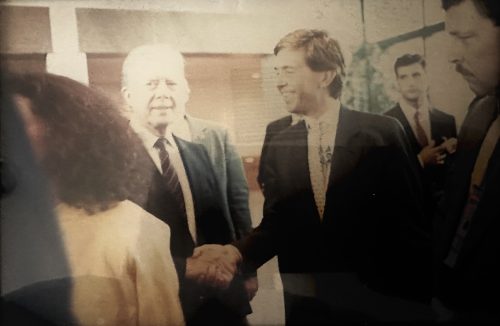
But it wouldn’t be long before George had to once again go into crisis management mode, potentially saving the entire presidency for Carter after a monstrous PR gaffe.
In the spring of 1976, before George had joined the campaign, Jimmy Carter had granted an interview to Playboy Magazine, that would be published later that fall. Playboy founder Hugh Hefner was an outspoken advocate for civil, LGBTQ and women’s rights, and in many circles was considered one of the most impactful human activists globally.
Many of the issues Heffner campaigned for were in line with the progressive platform Carter was running on.
Overall, the interview went well. Carter championed topics he was identifying as hot buttons for the election, and most of his points came across with poignancy and clarity.
History only remembers one part of the now infamous Playboy x Jimmy Carter interview though. In one excerpt, Carter -married since 1946- expressed “looking upon a lot of women with lust.” He confessed that he “commits adultery in my heart many times.”
The comments, understandably, received a lot of brushbacks. Jody Powel and others provided damage control, immediately downplaying and backpedaling from the interview.
The campaign went on hiatus, hitting the pause button for a few weeks until it was decided things needed to be restarted in Miami Beach.
Weeks later, while the issue of Playboy was still in circulation, they hosted a fundraiser for the elderly and arranged a one-thousand-person rally on the beach.
Carter, along with many of his top brass and donors, flew in the night before and were staying at the brand-new posh Konover Hotel.
The Konover -complete with a luxury cinema featuring valet parking, bartender service from your seat, and upscale snacks- had recently opened on Christmas Day 1975 with Sean Connery among others in attendance screening his film “The Man Who Would Be King.”
While seated in the lounge, George noticed that members of the wait staff were serving drinks in glasses that had none other than the Playboy logo on them.
As it turns out, the hotel was the former Playboy Hotel in Miami Beach, and many of the stationary had yet to be changed over.
“We were hours away from having media from all over the world, powerful insiders, and all of our top donors and sponsors coming into that hotel,” George recalls. “With the backlash from the Playboy interview still fresh in everyone’s minds, this was the last thing we needed in the media cycle. It would be a killer.”
Scrambling, George made a couple of phone calls and located the general manager, who happened to be in a corporate meeting in NYC.
Within hours, there were new glasses, sheets, and anything else that had the Playboy emblem engraved into it replaced throughout all four floors of the hotel.
“It was quite the scene,” George laughs thinking back. “In some instances, we were pouring a customer’s drink out of a Playboy glass and into a new glass while they were in between sips!”
On Election Night, November 2nd, 1976, Jimmy Carter held off Gerald Ford, by a little over one million votes (less than fifty in the electoral college) to become the 39th President of the Unites States of America.
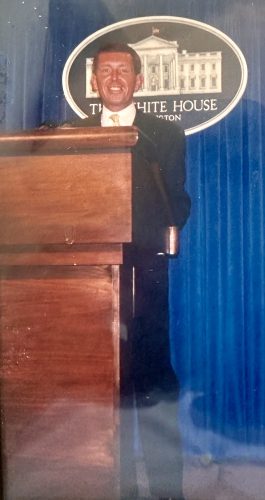
Impressed by the contributions George had made to the campaign, Powel that evening invited him to come to Washington DC for a few days to chill out, relax, enjoy the spoils of victory, and discuss his future.
Briefly returning home to Boston to gather himself before heading to the nation’s capital, George received a call from Mayor White’s office to meet him at Logan Airport that Sunday morning for a press conference.
The request felt a little unusual, but George complied and upon arriving at the airport was pulled aside by his old mentor.
“Are you ready to get back to work?” the mayor asked him.
“Does this mean I still have a job?” George countered.
“Listen,” Mayor White leaned in looking George directly in the eye. “Would you rather be a small fish in the ocean (working for Carter in DC) or a large fish in a small pond? We have a lot of work to do here, this will be the best thing for you and me.
George nodded.
“Just one more thing,” Mayor White added. “I don’t ever want to hear that son of a bitch’s name again!”
And just like that, Kevin White and George Regan were back in the saddle together, leading the city of Boston.
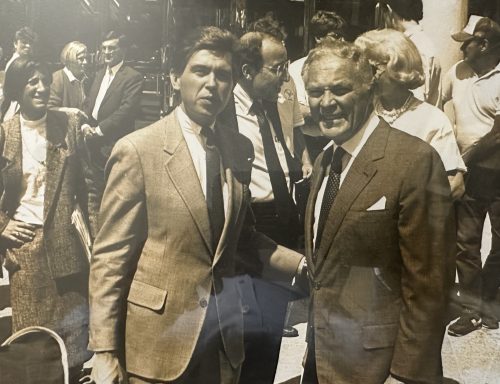
ON that list was to oversee the continued development of the recently christened Faneuil Hall Marketplace.
Once an assortment of crumbling, rat-infested buildings, occupied by just a few old cheese and meat companies, Mayor White had earmarked the land outside of his City Hall office as the focal point for his Urban Renewal initiatives.
When others argued that Boston was best identified as a collection of blue-collar, ethnic neighborhoods, Mayor White saw an urban mecca that could be a destination oasis for tourism from all over the world.
“He had a vision,” George says. “And he was determined to fulfill it.”
They were able to secure some federal money that helped jump-start the revival process. Following a host of interviews and walk-throughs in what was soon to become the Faneuil Hall Marketplace land, Mayor White and his top staff, including George, were able to convey their vision to a charismatic Maryland based developer, James W. Rouse.
With Rouse on-board, Chase Manhattan Bank of New York committed $10m to the project and after numerous, tireless meetings with almost every local bank in New England, (and twisting many arms,) they were able to secure another $10m from an agglomeration of eleven other banks.
“Lots of meetings, lots of dinner receptions, lots of schmoozing,” George states about what it took to raise the remaining funds locally. “Even once (Rouse) and Chase Manhattan wore on-board, there was a still a lot of resistance throughout the city on whether or not we could actually make this work.”
By its second anniversary in the summer of 1978, the Boston Globe was calling Faneuil Hall “a sparkling symbol of urban renaissance.”
It was a crowning moment, not just for Mayor White, George, and everyone else that saw the project through, but also a watershed achievement for the city of Boston that will withstand the test of time in her storied history.
The success of Faneuil Hall paved the way for the Big Dig, which paved the way for the waterfront revitalization, which ultimately led to the Seaport District as we see it today.
George, himself, sums it up best: “Kevin White built the foundation which made Boston a world class city.”
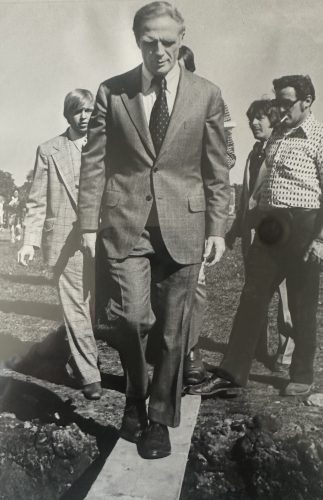
WITH the new-look Boston beginning to boom, Mayor White and George began zeroing in on potential high profile public figures they could host in the city.
A devout Catholic, George mentioned to the mayor, they should try and get Pope John Paul II -who had recently announced plans for a United States tour- to add Boston as one of the destinations for his papal visits.
Mayor White was upset Boston would be left off the list.
At George’s begetting, Mayor White called the cardinal to extend a formal invite, but was informed the invitation had to come from a “third party.”
The cardinal could be involved, he reasoned, but said calling the Vatican direct wouldn’t get them anywhere.
Befuddled on how to proceed, George told his mentor to let him handle it.
“It would have been crazy for us to try and find the right third-party person directly to invite the pope for a visit,” George explains. “So I figured why not do it publicly through the media?”
George hatched an idea to put a formal invitation to the Vatican on the front page of one of the local newspapers, and called an old-friend, Dan Forst at the Boston Herald, (then the Herald-American) to execute the plan.
In the invitation, George had the cardinal talk about the history of the city and had him play up urging the pope to come.
“We made sure that edition of the Herald circulated throughout the Vatican with the same velocity it was here in Boston,” George laughs.
“Within a week, we got a call from the State Department that the pope would be making Boston the first stop on his tour.”
On October 1st, 1979 Pope John Paul II became the second pope ever to step foot onto United States soil when he touched down into Logan Airport. (Pope Paul VI held mass at Yankee Stadium in the Bronx in 1965.)
“It took an astounding amount of preparation and security,” George emphasizes. “We set up a motorcade that brought Pope John Paul II through various parts of the city (and of course by Faneuil Hall) and then celebrated a mass in front of a crowd of 400,000 on Boston Common.”
THE Catholic Church played a profound role growing up -and still does- to this day for George in his life.
“You may not notice just by looking or talking to me, but I am a man of faith. I grew up with the Catholic Church and remain a practicing Catholic today,” he acknowledges.
In 1981, that celestial faith would be called upon heavily by George and all those who care for and love him.
Following an extremely serious accident, (out of respect for George’s privacy we will not go into specific details of the accident) George was under intense care at Massachusetts General Hospital rehabilitating and relearning the use of many of his extremities including those in his mouth and jaw.
“It was very difficult,” he says. “I basically had to re-teach myself how to speak.”
While mending, George became more involved with the Anti-Defamation League of New England, where his convictions for standing up for human and civil rights grew even stronger.
“Kevin White would always say to me, ‘If you have strong lungs and a voice, be sure to use it’ and after my accident, as I got closer with the ADL, that really resonated with me in a more powerful manner.”
George continues: “I became more determined than ever to stand up for worthy causes and use my voice with even more impact.”
Away from City Hall for four months healing, George returned to Mayor White’s side just as political campaigns were warming up for another mayoral election.
Having been in the seat since 1968, Kevin White was already the longest tenured mayor in Boston’s history.
“Neither one of us had to say it to each other, but we were both exhausted,” George admits. “We both knew deep down we weren’t going to be coming back for a fifth term.”
Even so, Mayor White, top aide Micho Spring, and George wanted to fully evaluate the city’s landscape and make sure any decision they moved forward with had Boston’s best interests in mind.
Led by city councilor Raymond Flynn and former state representative Mel King on the ballots, Mayor White knew that if he were to not seek re-election, the city would be left in good hands.
Yet, without officially announcing that he was abdicating the throne, speculation persisted throughout the city that the mayor would be running.
This culminated, with a front-page story by Boston Herald columnist Peter Lucas in May of 1983 that boldly proclaimed: “WHITE WILL RUN” as its headline. Hours later, Mayor White and George officially announced that they WILL NOT be running in the upcoming election.
How this media faux pas came to be had been hotly contested and part of Boston’s political gossip lore for the last forty years.
“I’ll tell you exactly what happened,” George exclaims.
“Peter Lucas had been very aggressive in trying to get Kevin to say he was going to run. It was to the point we were basically avoiding him. A few days before Kevin announced his intentions, there was an accident involving Peter’s daughter who was severely injured. Kevin called Peter to extend his care and well wishes,” explains George.
“Immediately Peter begins asking about the election. ‘Don’t do this Peter’ Kevin said repeatedly, but Peter kept persisting. He said, ‘Bob Page (then publisher) fire me if I say you’re running?’” George shakes his hand.
“ALL Kevin replied back to that was, ‘Peter, Bob Page loves you. He will never fire you.’ That’s it. That’s what Peter ran with. He took that as Kevin’s confirmation he was running.”
And on that note, after 16 years serving the city of Boston as mayor, almost 12 of which saw George K. Regan Jr by his side, Kevin H. White bowed out as the city’s chief executive.
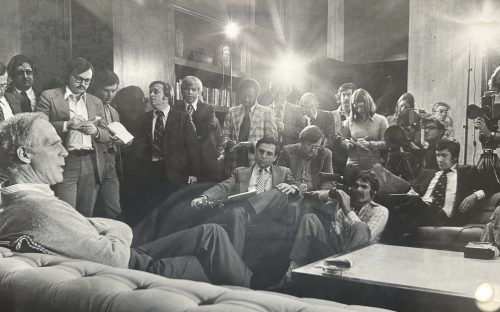
PART III – Building an Empire
ONCE again, George K. Regan Jr finds himself sitting in a highly decorated executive office -brand new good luck underwear from Ann wrapped snug around his waist- in front of a powerful leader in Boston, having a conversation pondering his professional future.
The man behind the mahogany desk this time is Jack Connors, founder of Hill Holiday, one of the largest and most successful advertising agencies in the country.
The year is 1984, and despite by his early 30’s having built a resume compiled of the ‘Who’s Who’ of power brokers, political insiders, and media magnates throughout the country, George is quite certain he is ready to put the world of public service behind him.. at least for now.
Connors, smoking a fine Cuban cigar, is paying more attention to the golf balls he is putting around his office, than he is George.
“Spending the last 11 and a half years with Kevin,” George begins, briefly wresting the ad mogul’s attention from the office putting green. “If there is anything I have become an expert on, it’s crisis management. I’ve brushed shoulders with the best of the best around the globe in this field and I’m as good at this as any of them. I’m thinking of starting my own public relations agency.”
Connors looks at George in silence for a few seconds before speaking. A look of annoyance breaks across his face.
“Kevin (White) was telling me about this,” he sighs. “This is truly the stupidest thing I’ve ever heard.”
The meeting barely lasts fifteen minutes.
“Right as I was getting ready to leave,” George says. “Jack casually throws out in an ‘oh by the way’ type way that he is opening an office in Europe for his biggest client, The Wang. He tells me he’ll send me out there for five years to run some PR for him, and then I can come back to the US to work at Hill Holiday.”
The two shake hands and agree to check back in with each other later in the week. As George departs, entering the elevator, he begins to process Connors offer. He has an epiphany.
“It hit me. Jack Connors offering me to roll my visions of an agency into his new division in Europe was all the confirmation I needed that my concept was solid. I decided right there in that elevator that I was going to start Regan Communications.”
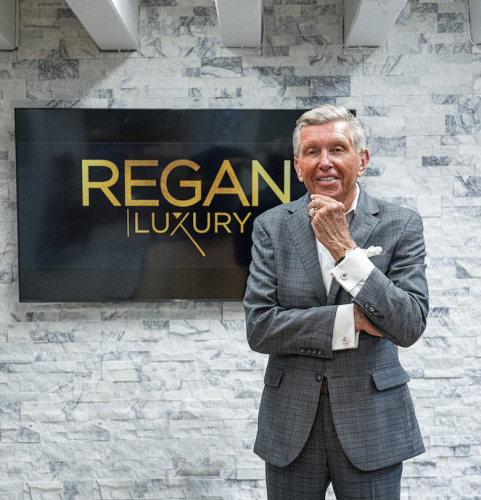
To get his agency off the ground, George rounded up a small group of investors -including one Jack Connors- that extended a $25k loan each to him for initial funding. The very first Regan Communications employee directory, showing five names total, includes his sister Patricia and Aunt Mary as well.
“My Aunt Mary was always a second mother to me,” George gushes. “I tell people all the time, I had the blessing of growing up with two mothers that loved and cared for me.”
That motherly love and nurture went well past any adolescent phases and extended over to the launch of Regan Communications.
“Aunt Mary quit her job as an accountant at Red Coach Grill to be part of the agency,” says George. “Early on, during weeks where we struggled to make payroll, she made withdrawals from her retirement and savings accounts to cover our expenses. She played a very important role in helping our company in getting things moving.”
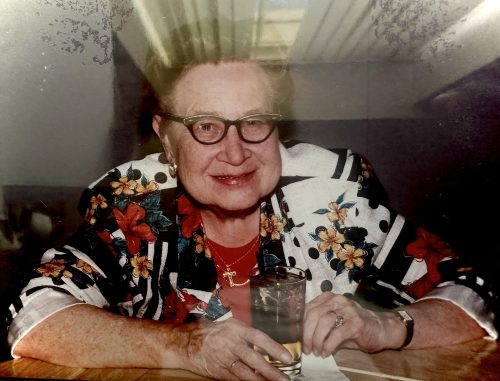
And once things got moving at Regan Comm, they accelerated quickly. As it turns out, George’s hunch that there was a need for an expert crisis management firm -not just in New England, but in every corner of the country- was spot on.
Steve Crosbie from Crosbie International Publishing became the first major client, stabilizing the finances and providing further confidence and proof of concept. Aunt Mary wasn’t having to dip into her savings any longer to cover payroll.
From there, the ‘Tipping Point’ materialized. Clients everywhere -large and small; national and regional- began seeking out the services of the man being hailed as “the master of spin.”
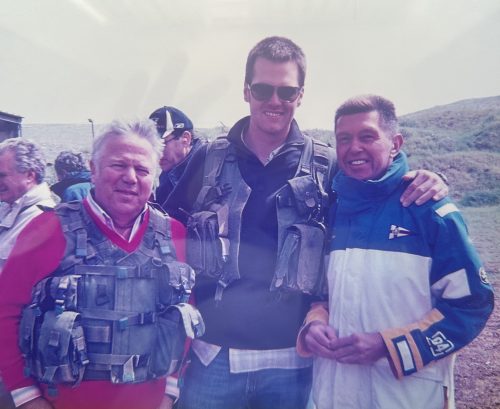
Suffolk Construction, Legal Sea Foods, New Balance, SBLI, The Boston Celtics, New England Patriots, Boston Magazine, Simon Property Group, Friendly’s Ice Cream, Dunkin Donuts, Bank of America, State Street Bank, and American Express are just a few in the portfolio that came knocking at the door of George’s waterfront offices.
It was the latter with whom George brilliantly exhibited one of the most impressive crisis averts of his career.
AMERICAN EXPRESS in the 1980’s, through a series of acquisitions, was making a powerful push to enter the world of financial holdings, thus creating an investment banking arm.
Positioning themselves -and their holders- as the credit card of prestige, AMEX began implementing an experiment at the end of the decade around Boston where they cut their interchange fee (also known as a “discount rate”) to merchants and restaurants providing they accepted only American Express and no other credit cards.
This, predictably, outraged competitors such as Visa and Mastercard as the tactics locked restaurants -and their customers- out of the choice of using other cards.
Capitalizing on this elitist image, American Express frequently mentioned their ‘exclusive partnerships’ in bougie ad campaigns.
However, the monopoly would not last.
A group of restaurants in Boston banded together and stopped accepting American Express outright; encouraging the use of Visa and Mastercard, including some that were previously exclusive to American Express prior.
The rationale was due to far lower fees compared with American Express’s fees at the time (4% for each transaction versus 1.2% for Visa and Mastercard).
“It was ‘Boston’s Great Restaurant Revolt,’” George exclaims. “We kind of chuckle a little about it now, but things got really sticky for American Express for a bit.”
The revolt, also known as the “Boston Fee Party” quickly spread to over 250 restaurants across the United States, including high profile establishments in New York City, Chicago, and Los Angeles.
Visa, smelling blood in the water, offered to pay the legal bills for the entire coalition of restaurants joining the Boston Fee Party.
“That’s when we got involved,” simpers George.
Talks had all but broken down between AMEX and the restaurants participating in the revolt.
“Luckily I knew many of them (restaurants) well,” George says. “And knew in good faith if given the opportunity I could negotiate an arrangement that would get AMEX back in there.”
George proposed to American Express CEO Kenneth Chenault that he immediately cut fees to be brought back into the fold with the revolting restaurants. He also suggested that they implement a strategy softening their position on exclusivity, therefore broadening their mainstream acceptance.
Chenault signed off on the plan, and by 1991 American Express’s portfolio -and reputation- had been restored.
Furthermore, the more inclusive branding opened previously shut doors for mainstream merchants like Walmart to be added to the American Express network.
“American Express remains a trusted and loyal client to this day,” George points out. “Negotiating that deal was a big moment for us.”
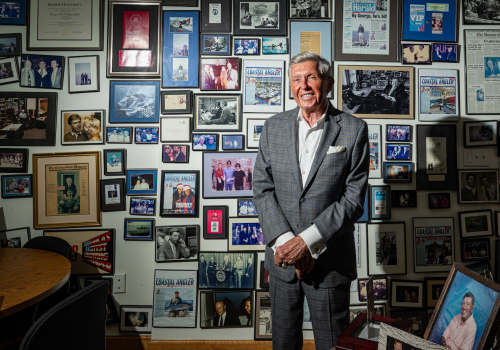
PART IV – Love at Last
PERHAPS it was a Sunday Globe story, almost a throw away statement, buried in the ‘Focus on Politics’ section from July 2nd, 1978 that describes it best. A simple line, calling George “a bachelor wedded to his job” ended up being a title, although who could have known at the time, he would carry for some 40+ years after first written.
“It’s not that I didn’t have girlfriends,” George says. “I am just blessed to have a very good understanding of what family and love is, thanks to my own family. I definitely met many lovely people over the years, I just wasn’t going to give my heart to someone until I felt that feeling of family with the right person.”
That feeling of family. It’s a feeling George Sr and Ann most certainly felt, first on a bus ride in 1948; and then held on to throughout the decades.
It’s also that feeling of your Aunt Mary, committing every fiber in her body to first care for her little sister, loving her like her own child. And then later providing that same love for you and your siblings.
It’s the feeling of the love; the belief; the comfort you feel with your two sisters. Siblings, who you do anything for, and who in return do anything for you. Like your sister, Patricia, who was with you the day you opened Regan Comm, giving you everything she could, even as she battled her own demons.
That feeling of family. The power of that strong, beautiful force; so powerful, it can also be a feeling of heartache. A feeling felt when losing beautiful Patricia, at only forty years old to the heartbreaking struggles of anorexia.
“She was only 39 pounds when she passed away,” you tell me. “Losing her was the worst feeling, we all went into a deep depression. I’m okay to talk about it now though. Talking about it is the way we hopefully one day overcome these horrible conditions.”
That feeling of loss hurts the way it does, because of the overwhelming feeling of love and fulfillment your family gives you.
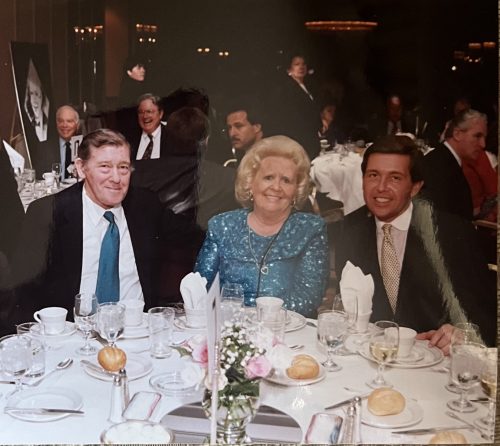
It never hurts less. You feel it again when Aunt Mary passes away a couple of years later. And again when you have to say goodbye to your best friend, George Sr. And once more, just a few years ago, to the person you’ve been closest to throughout your entire life, your mother Ann.
It’s because of these people you know what family feels like and what family is. It is because of them you have an innate understanding of what the feelings of indescribable love and family are.
These are the reasons -not because of work- that the media, for all those years, labeled you a bachelor.
You were at peace with that. Blessed to know what family and love feels like and grateful to have felt it with yours. You realized you may never feel it again, but you were okay with that.
And then you met Elizabeth.
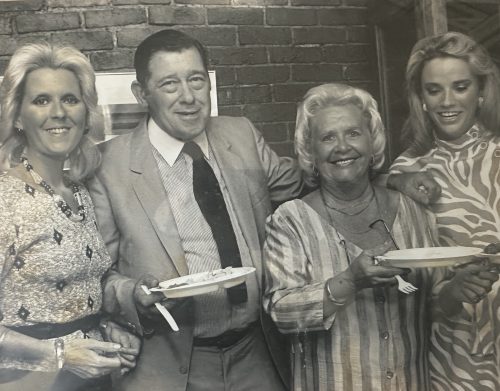
PUBLISHER’S NOTE: The beautiful love story of how George and Elizabeth met and married has been perfectly told in the pages of George’s longtime client Boston Magazine. I would be doing it a disservice if I attempted to re-tell it any different. Below, from the August 2023 edition, titled “Destination: Love at Last” (pages 28-30,) and written by super scribe Stefanie Schwalb, is the fairy tale of George K. Regan, Jr and Elizabeth (Ackley) Regan.
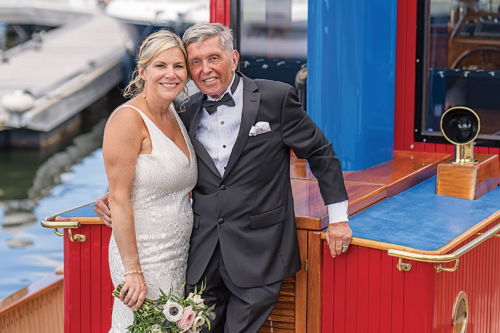
The meet cute. Without it, how would romance movies exist?
But even Nora Ephron might struggle to write a love story as endearing as George Regan and Elizabeth Akeley’s. The former longtime bachelor is the founder and CEO of Regan Communications Group (whose client list includes heavy hitters such as the Boston Celtics, New Balance, and Boston Magazine); the latter is the thoughtful, vivacious JetBlue flight attendant who captured his heart.
Their chance encounter, appropriately enough, took place on a flight leaving Logan Airport during the first week of the pandemic.
“My company has an office in Jupiter, Florida, and they made a big mistake. My mission was to fly down and to try to fix the mess,” George explains. “It was the first day the governor declared a state of emergency and basically closed everything down.”
After Elizabeth helped him figure out how to work the TV screen on the plane, some banter ensued, and George was smitten. He then proceeded to ask her out for dinner the next night, but she told him she didn’t date passengers. His response?
“I said, ‘Don’t flatter yourself. I have no intention of ever dating or marrying you. You just looked hungry.’”
That made her laugh, she says, and he’s been doing so ever since. From there, the couple embarked on a unique courtship given the constraints of the time, which they say worked in their favor.
“The pandemic was in full swing, and JetBlue asked if we would take leaves of absence to help the company, so I did,” Elizabeth continues. “That gave us a lot of time to spend together, and I think that built the foundation of our relationship, which we wouldn’t have had before. People weren’t going out and seeing other people, so it gave us an excuse to spend even more time together.”
In stark contrast to the solitude of their romance’s early days, George and Elizabeth’s wedding day was packed with family and friends—400, to be exact. While coordinating an event of this magnitude did pose some challenges, everything ultimately came together.
On a beautiful July day last summer at Nauticus Marina in Osterville, numerous current and former politicians, business magnates, and other Boston luminaries gathered for the grand celebration.
The Dress
Designed by Made with Love Bridal, the bride’s dress—called the
“Georgie”—featured Irish lace with shamrocks on it.
“I love it because I thought it was a nod to George’s Irish heritage,” Elizabeth says. “In fact, he’s currently working on getting his Irish passport because his dad was a first-generation Irish immigrant.”
The Cake
Boston baker extraordinaire George Montilio created a beautiful four-tier wedding cake for the big event after the bride attended a special tasting with the master himself.
“It was fantastic,” she says, “and we used the topper from George’s parents’ wedding cake—which was more than 70 years old—on ours. That was really special, too.”
In fact, the groom admits it’s something he never would have thought of.
“Elizabeth actually found it in a box in the house. It was just such a beautiful touch, but that’s Elizabeth.”
The Ceremony
Officiated by former Governor Charlie Baker, the ceremony began in a cinematic fashion with the bride arriving via a refurbished tugboat owned by Suffolk Construction CEO John Fish and to a soundtrack of gospel stylings from the Celebration Singers.
“For those who know George, we would never have thought this day would come,” Baker said during the ceremony. “But after all, he did have to go as far as 35,000 feet in the air to find the one woman with whom he trusted his heart.”
The Proposal
Even though George was forewarned by Elizabeth’s father that she hates surprises, he opted to propose at a lighthouse on Nantucket.
After getting her there via helicopter under the guise that it was a magazine photo shoot for former police commissioners William Gross and Bill Bratton, a 7-mile Jeep ride ensued, during which Elizabeth was relegated to the back seat.
Meanwhile, 175 friends and family were waiting at the Willowbend Country Club to celebrate their engagement. While the groom admits he wasn’t totally sure she’d say yes, he had a backup plan.
“We had two signs made up: She said yes. She said no.”
Thankfully, Elizabeth chose the former.
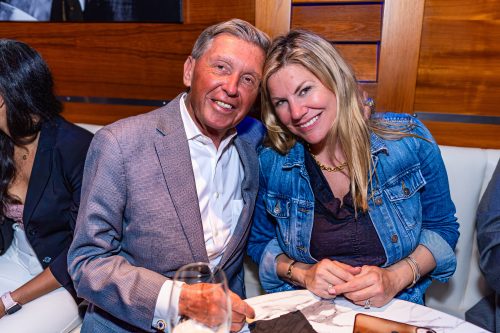
PART V – The Voice in the Arena
IT’S no secret George K. Regan, Jr is outspoken. Ask anyone that’s ever known him for longer than a week.
“Elizabeth and I were driving back from Gillette (stadium) after seeing Taylor Swift in a monsoon with her five-year old niece Lulu in the back seat. I was telling some story -no more and no less animation than I normally do -all of a sudden she blurts out, ‘GEORGE, WILL YOU JUST SHUT UP ALREADY?!’”
George can’t help but crack a smile while telling this story.
“I turn around and say to her: ‘Young lady, do you know how many people would love to have said that to me over the last fifty years?”
While at the wedding reception of his good friend former Boston Police Commissioner Willie Gross earlier in September -a wedding George shared co-ring bearer duties with Commissioner Gross’s Maltese for- officers past and present come by and thank George throughout the evening for his unwavering support and commitment to them over the years.
At one point, a high-ranking official, poses to George:
“It’s tremendously appreciated by all of us for everything you do, but why do you do it? Wouldn’t it be easier just to keep your mouth shut sometimes? Wouldn’t it make more sense financially for your business to stay in a neutral position on matters?
And herein lies the great complication of the world -the city of Boston- in 2023. Yes, it would be easier.
“Oh, I’m sure I’ve lost a lot of money over the years by speaking up, but that’s okay because anyone who knows me knows I’m not about the money” George says. “I’ve lost clients who have told me we differ on things, and I’m sure I’ve lost what would have been future clients that never said anything because they don’t have a voice.”
But life isn’t about doing what’s easiest. It’s not about staying in neutral. The ones that stay in neutral are the ones that lose their voices. If God gives you healthy lungs, consider that a blessing and use them. George’s great mentor, the late Kevin H. White taught him that. In return, he is now passing that invaluable lesson on to whoever listens. To whoever speaks. To whoever CARES.
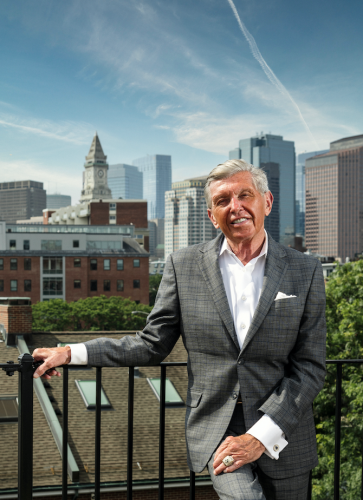
“Moral courage,” Robert F. Kennedy said in his Day of Affirmation address. “Is a rarer commodity than bravery in battle or great intelligence. Yet it is the one essential, vital quality for those who seek to change a world that yields most painfully to change.”
There is something to be said for always trying to do the right thing, no matter the cost. There is something to be said for always using your voice for worthy causes.
When Theodore Roosevelt spoke of it not being the critic who counts; and the man in the arena that matters, he was saying it is the VOICE in the arena that matters.
George K. Regan, Jr has been that voice for the city of Boston since the day he penned his first byline as a teenager in the Boston Globe.
“It’s definitely not easy,” George admits to me, 2,500 feet in the air as we shuttle via helicopter from his Willowbend Country Club in Cape Cod to a lunch at Great Harbor Yacht Club on Nantucket Island.
“But I never take unnecessary risks. And the rewards from the dedication are far more fulfilling than anything I may have lost. I consider myself very blessed for the life I live, the life I have been given. I consider myself lucky.”
Of course he does. And he has the endless sets of good luck underwear from Ann to prove it.
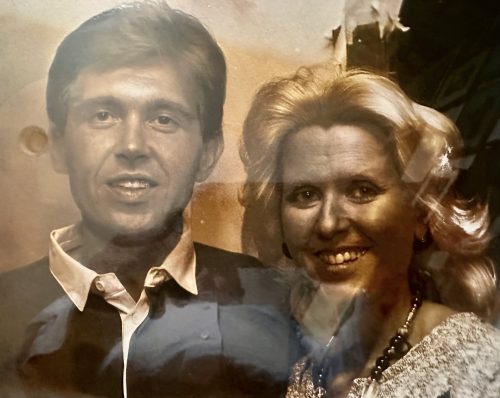
***
